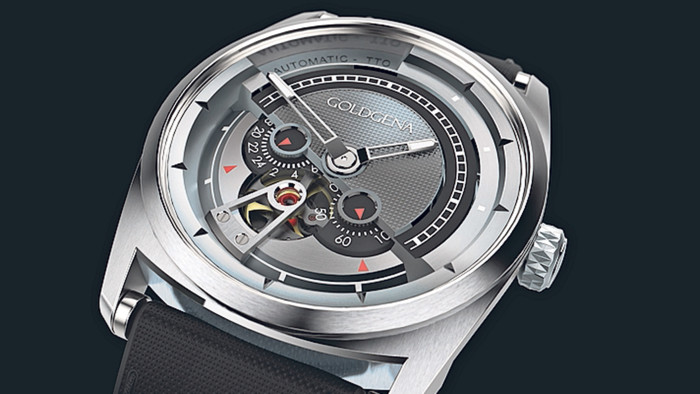Goldgena Project’s radical transparency riles watch industry

Roula Khalaf, Editor of the FT, selects her favourite stories in this weekly newsletter.
If you took the label “Swiss made” to mean a product entirely made in Switzerland, you could be forgiven — but you would also be wrong. Although manufacturers are often cagey on this point, a watch’s movement need only be 50 per cent Swiss by value, then assembled and inspected there, to meet the “Swissness” test. This will go up to 60 per cent — for the movement and for the whole watch — from 2017, but there is still nothing to indicate that a Swiss-made watch might have a substantially Japanese movement or a Chinese case.
Before that happens, however, a brand so insurgent that it has yet to give itself a name is promising to disrupt the industry’s cosy silence. The company — currently operating under the code name “The Goldgena Project” — has a new concept it is calling “TTO”: total transparency on origin. This will not only make clear from where its watches’ parts have come, but also how much they cost to make and how many times that figure is multiplied to reach the retail price.
Goldgena was set up by 40-year-old Claudio D’Amore, who worked with celebrated designer Ross Lovegrove on several TAG Heuer models before setting up his Lausanne-based business Cosanova in 2005. Cosanova has since been involved in designing watches for about 40 brands, including Parmigiani, Oris and Eberhard.
Mr D’Amore launched Goldgena in late March, initially by explaining the meaning of horological “Swissness” on its website. Two weeks later, he publicised the industry wisdom about how many times most brands multiplied their costs of production: between six and eight, and in some cases 10. More competitive brands had a multiple of five.
The retail prices of Goldgena watches, however, will be 3.5 times the cost of production, Mr D’Amore says, a multiple he believes will be feasible because the brand will operate without the traditional network of distributors and retailers. Instead, it will sell its watches through its website and then “drop-ship” them, meaning delivery to the customer through an ecommerce partner, pop-up stores or the project’s “community”, who will receive 10 per cent of the retail price for every sale they generate.
By early August, 10,000 people had registered to make suggestions about the design and the development of the first model, how much it should cost and where the majority of its components should come from. After incorporating some of the crowd’s suggestions, Mr D’Amore hopes to have a functioning prototype available this month — as well as a definitive dial name — before launching a crowdfunding campaign in October. If all goes to plan, production will begin in November and the first watches will be delivered in April.
He admits the project has upset the industry to the point that some well-known brands no longer want to work with Cosanova — but he appears to have no regrets: “I think our idea of TTO — which other brands can sign up for — is good not only for the consumer but for the Swiss watch industry itself,” he says. “Many parts of many Swiss watches are made in China — but that doesn’t have to mean anything negative. It simply shows that Swiss makers know how to work with the best people and find the best suppliers.” His complaint is that a Swiss-made watch could have 90 per cent foreign components.
Mr D’Amore has so far invested SFr20,000 ($20,400) of his own money into Goldgena, most of which has been spent on promotional videos, digital marketing and the creation of its website. He says the crowdfund campaign needs to raise a minimum of SFr250,000 before production can commence, although he would be more comfortable with SFr1m or more.
“Our first-year goal is to make 1,000-5,000 pieces,” he says. “We will start with a single design, which will contain a Japanese Miyota mechanical movement and be assembled in China using largely Chinese-made components. It will probably cost us around SFr200 to make and will retail for SFr700. Our profit will be around two-and-a-half times the production cost, with the remainder covering logistics and shipment.”
One of the few people from the mainstream Swiss industry willing to comment on Goldgena was Rolf Studer, joint chief executive of Oris (one of Mr D’Amore’s customers at Cosanova). Oris largely makes watches in the SFr1,000-SFr3,000 price range, exclusively with mechanical movements.
“I think the times which the industry is going through right now call for fresh ideas, and being transparent and taking the fluff out of things is something that should be welcomed,” says Mr Studer. He is referring to, among other things, a 11 per cent fall in Swiss watch exports in the year to July 2016, according to the Federation of the Swiss Watch Industry.
“The ‘bling’ era is gone,” Mr Studer adds, “and people are certainly looking for genuine value — but what does that actually mean? Does it really give a consumer added value to know where every wheel and screw has come from? I don’t think so . . . There are already plenty of watches on the market which combine a good price with reliability, so [Goldgena] will have to rely on the concept for its success. Whether or not that concept represents actual value . . . we will have to wait and see.”
Comments